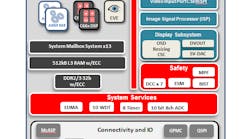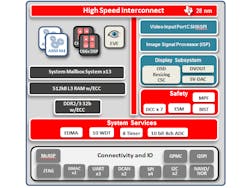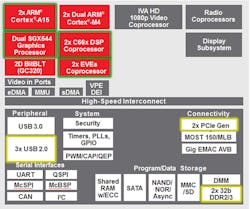Advanced Driver Assistance Systems (ADAS) are taking on more chores as the underlying chips become more powerful. These systems are incorporating more sensors including multiple high-definition cameras that significantly increase the bandwidth of incoming data that needs to be integrated before presentation to the driver.
This file type includes high resolution graphics and schematics when applicable.
Texas Instrument’s (TI) 28-nm TDA3x targets ADAS. Its advanced EVE vision accelerator and an image signal processor (ISP) can handle four-camera, surround-view, image integration. The system has dual C66x DSP cores and dual ARM Cortex-M4 cores (Fig. 1) allowing it to provide services such as lane keep assist, autonomous parking, adaptive cruise control and blind spot detection.
In typical applications the chip uses 1 to 2 W of power. It is available in 15- by 15-mm and 12- by 12-mm chips with package-on-package (PoP) support. This support allows integration with a range of third party LPDDR2 memory chips although for some applications the on-chip memory may be sufficient. Versions are available with up to 512 kbytes of ECC RAM for the L3 cache.
The family includes a range of chips allowing it to also target entry and mid-level automotive applications.
And now for some Infotainment
For infotainment applications, TI is offering the Jancito 6 family (Fig. 2). The dual ARM Cortex-A15 cores are augmented with dual core Cortex-M4 cores and dual 1.4-GHz C66x DSPs. It is designed to handle robust display chores with dual SGX544 graphics processor and up to two EVE image coprocessors. The chips can provide augmented navigation support and features like driver recognition via image recognition of video from an interior camera. It allows designers to present a virtual dashboard with more flexibility than a conventional dashboard.
The Jancito is designed to handle streaming audio as well as video chores. It can even handle HUD support (heads up display). It can recognize objects and pedestrians.
The Jancito family incorporates a range of communication interfaces including gigabit Ethernet and 150 Mbit/s MOST. PCI Express interfaces allow access to external support hardware. The top end includes USB 3.0 support.



